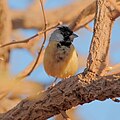| Coal-crested finch | |
|---|---|
 | |
| male at Codó, Maranhão, Brazil | |
| Scientific classification | |
| Kingdom: | Animalia |
| Phylum: | Chordata |
| Class: | Aves |
| Order: | Passeriformes |
| Family: | Thraupidae |
| Genus: | Charitospiza Oberholser, 1905 |
| Species: | C. eucosma |
| Binomial name | |
| Charitospiza eucosma Oberholser, 1905 | |
 | |
The coal-crested finch (Charitospiza eucosma) is a species of bird in the family Thraupidae. Though previously classified in the bunting and American sparrow family Emberizidae, molecular phylogenetic studies have shown that it is a member of the large tanager family Thraupidae. It is the only member of the genus Charitospiza.
Contents
It is found mainly in the Cerrado, with small amounts in Bolivia and northern Argentina. Its natural habitat is dry savanna. It is threatened by habitat loss. It feeds on seed of plants specifically found in these habitats.


